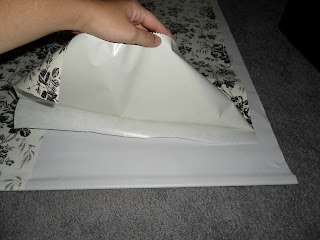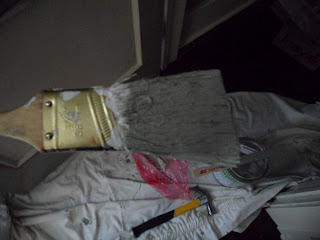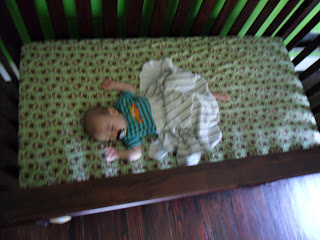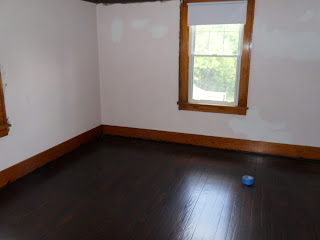All 3 bedrooms needed the floor refinished. So after some initial work, we got started on sanding the spare room's floor first.
We're still not too sure what the marking in the middle of the room is, but it appeared on all 3 floors. We rented a floor sander to get the bulk of the work done.
It took a bit longer than expected, but eventually the room was done. While Jason continued working on the next room, my dad began to stain this room, just to see what the color would look like.
It wasn't exactly the color that I was looking for, and I hoped it would look a little "cleaner." Without sanding inbetween coats (the jury was out on whether it was worth it or not), Jason began to stain the floor for the second time. Since he had been working on his hands and knees hand sanding the other floors, I decided to give him a break. He discovered that if you wipe the stain clean after application (you know, what you're supposed to do), it wiped almost all of the stain off. So we decided just to clean it off the with paint brush. We're still not sure if this was a terrible or great decision. I'm not sure we care. When it was done, the finish looked a ton better, but when it dried, the red mahogany was comically red in the light.

The picture shows how "clean" it appeared, but you can't appreciate the scary shade of red that appeared. After a few more days, the color started to grow on us though, and by that point, we were sick of sanding and staining, so we made the jump ahead to seal the floors.
After the first coat of polyurethane, we loved the finish on the floors. I think this is what inspired us to do more with the room than originally planned.
We originally were going to make the spare room neutral. In fact, we were going to use the same paint color as the living room/entrance/stairs/hallway. After all of the work we've put into the house, I decided that "neutral" just wasn't going to cut it any more. This was going to be my work space in addition to a spare bedroom. I wanted it to be fun and funky, and I didn't care if it wasn't the most inviting for those very rare overnight guests that frequent our establishment.
I quickly decided that I wanted a shade of yellow. It brightens my mood and cheers me up, so I thought it would be the perfect color. (Web Reference to Color Psychology) I was trying to find a way to incorporate the brown that was used on the upper trim with the red shag rug that used to be in our living room with a shade of yellow that fit both of them. It was a painful and fruitless cause that ended with the realization that the gross shag rug (I swear, you canNOT keep it clean) was going to get a new home in the attic. This opened up my options greatly. Jason brought back some design idea cards from Lowes, and I quickly fell in love with this one. I loved how the colors worked together, and I wanted to figure out a way to incorporate them into the room.
Jason had to patch a few spots on the wall and ceiling in the room, and once they were ready, we primed and painted them. After yelling at Jason (sorry again, hun) for not painting where I asked, he informed me that he did indeed paint over the spots that were primed. This is when we realized that the ceiling paint we bought was dramatically different than the old color. And now, we had to paint the entire ceiling. Ugh.
Another valuable lesson was learned during this task. First of all, painting a ceiling is a ton more difficult than it looks. I thought, "okay, it's a wall above your head." Not so much. There are all kinds of waves and bends that make painting a complete pain! I had to take a break, because Micah and I were hungry, and I was losing my mind. The next lesson that I learned was, once you start painting something, leave it alone until it has completely dried. I tried coming back later that night to finish the job, and part of the paint had started to dry in the pan, and it was leaving streaks of dried paint, and I accidentally went over a slightly wet spot on the ceiling and the whole thing turned into cottage cheese. Well, shoot.
To make matters worse, I took that putty knife back out the next morning and tried to pick away at the excess paint chunks. Now there are holes in the ceiling. It will stay that way, because I have retired my ceiling painting skills for everyone's benefit. Seriously. Who looks up at the ceiling anyway? Stop looking.

I couldn't figure out how to work in the molding that went around the top of the wall, and on a whim, I grabbed the pry bar and tried yanking a section off of the wall. The wall was dirty under it, but it looked like it could work. The next day, I yanked out all sections of the molding in hopes of putting it at the top of the wall as crown molding. This was going to be awesome! As I was making the decisions about what colors would go on what parts of the room, I started to realize that my crown molding idea was a big flop. The molding was level with the top of the windows and door frame, which means, there were multiple sections of the room that would not have trim. It was a sad discovery, but I'm glad I realized this before I painted any of it.
Once the trim was gone, I used a putty knife to scrape the excess paint build up off of the walls. The nail holes and some cracks needed some spackle, so I filled them in. Once that was dry, I primed all of the previous trim, making sure to go over all of the brown that marked around the former trim. I later realized that I should have washed the walls before priming them. I had done a quick wash once the floors were done, just to get rid of the sawdust, but there was some gross-ness that built up under the one wall's trim from a former leak in the attic. As I was painting, it turned the white primer into grey primer. Oops.
When the primer dried, I started cutting the grey parts of the room. This included the baseboards, part of the door, one window and one wall. That took a lot longer than expected, and even though it was getting late, I was determined to get more work done. I knew that in order to get a finished look by the next day, I would have to add the black wherever I could. So I painted the window on the future yellow wall and the cut-outs on the door (both sides). At that point, I called it a day.


The next chance that I had to get painting, I moved right into touching up the previous black parts in addition to painting the second window (on the grey wall). I decided to try this window a little differently since the first one turned out so poorly. In order to get a clean line and not screw up the plastic part of the window, I did use a painter's tape on the inside of the window. My experience with painter's tape has not gone well, and in addition to occasional (paint) bleeding, it also rips off my previous or current paint color. The point of using this tape around an edge is so that your hand doesn't have to be exact. When the freaking tape rips off the old paint, then you have the exact same problem all over again, just with a different color and a nice little hole in your wall. Either way, the tape wasn't going to work, and my fine paint brush skills definitely weren't cutting it. I needed another solution.


This is the yellow wall's window. It doesn't look terrible, but if you look closely, you can see where it bled over into what will be yellow paint. The yellow is so thin that the primer shows through. Trying to get the yellow to cover black is going to be a nightmare. So on the grey wall, I wanted a better solution that would still give me as much of a clean line as I could get without sacrificing the grey paint that I already put on the wall.

Thanks to some inspiration from my sister, I decided to try a non-traditional approach. I had a ton of color cards that we got at the Home Depot when deciding what color to paint the wall. I started by ripping some up to create a border around the bottom of the window (the hardest part). Then I realized, I could continue up the sides of the window as well. It took tearing a few pieces and trying to fold a "straight" line before I realized I should just find the scissors. I thought I should cut on the lines, but that only gave me 4 pieces per page, and honestly, I couldn't even stay straight on the white line, so I just cut them into small strips as evenly as I could. The little pieces of painters tape holding them down wouldn't be pushed down hard enough to remove any paint, and in the off chance that they did, I figured it would be easier to spot treat those errors than ones close to the black paint. My next epiphany came when I got halfway up the one side of the window and felt the cards starting to fall onto each other. I should have started at the top to let gravity help me hold the cards down. I continued from the top and connected them at the middle on the right side, and went top down on the left side.

I figured that it couldn't look much worse than the other window did, so it was worth a shot. This is how it looked before I started painting (obviously). I did have to hold the cards down at times, so I got a little bit of paint of my fingers. You might laugh at that obvious statement, but I needed to be aware that I had wet black paint on my fingers and to make sure not to touch any other part of the room until I cleaned them off (a surprisingly difficult task). While it did take a little bit of time to prep the window, it was surprisingly less stressful than the one that I did free-hand.

As expected, the paint went on very faint, just like the other window. I could sand that finish until I was blue in the face, but the amount of varnish on those windows (and doors) was never coming off with my 220 grit sandpaper and baby soft hands. Three coats were in my future. The edging didn't quite need all 3 coats though, making it even less stressful. On the second (or third) coat, I dripped a little onto the grey paint. I quickly grabbed Rachel's "magic spray" onto a paper towel and wiped away the stain with little evidence.
Once I had completed the black parts of the room, I moved onto the yellow walls. I toggled between cutting and rolling in order to preserve my sanity. I made it a good way around the room before taking a dinner break (yes, it took most of the day just to get the black parts painted or touched up). When I went back to work after dinner, I started making stupid errors. See photo below to discover what happens when you stop paying attention to your work space.
Fortunately, I noticed that I had now successfully painted one leg of the ladder yellow before moving it onto an un-clothed floor. Side note, the pouring attachments for the paint cans worked wonders in addition to the handy paint bucket things with removable (and disposable) liners. The lids made pouring into the buckets or rolling pans a lot easier, especially after freshly breaking the seal for the first time.
Yet again, I digress. As expected, the yellow paint went on very thin and would definitely need multiple coats in order to cover the various marks on the wall. It's definitely a bold look to the room and not for everyone, but it's coming along.
And here's the finished look of each of the windows. The paint color cards made the grey window look a ton better than the yellow window, and I will definitely use this method again (but maybe with actual card stock instead of the paint cards, which were the only resource we currently had since our lives are in boxes in a storage unit on main street).
After 3 coats of yellow paint and 2 coats of grey, you can barely see where the molding used to be on the wall. Honestly, the worst part of the wall is where the ceiling paint ran down a little. We're still debating resurrecting the molding to use as crown molding. I asked Jason to paint the quarter round while I was working on the walls, and he accidentally painted the molding instead. I never intended to use black crown molding (I only wanted the quarter round to be black), but now we're considering the idea if we can find the extra pieces that we're missing at an affordable cost.
The room is quite bright and a little shocking (go big or go home), but I think that once we get the furniture in there, the total effect will show through, and it will be a cheerful and quirky room of its own! I can't wait to see it completed!

































































